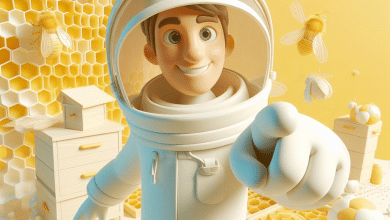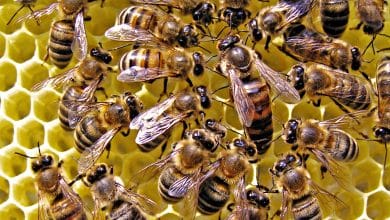how many eyes does a bee have

how many eyes does a bee have. Bees are fascinating creatures that play a vital role in our ecosystem. They are known for their impressive ability to pollinate flowers and produce honey, but have you ever wondered about their vision? Specifically, how many eyes does a bee have? In this article, we will explore the intricate anatomy and vision of bees, shedding light on their unique visual capabilities.
When it comes to their eyes, bees have not one, not two, but five eyes! Two of these eyes are large compound eyes, while the remaining three are smaller ocelli eyes located in the center of their head. The compound eyes are the main visual organs of the bee, providing a wide field of vision and enabling them to see in multiple directions simultaneously. The ocelli eyes, on the other hand, are responsible for detecting light intensity and direction.
Understanding the number of eyes a bee possesses is just the beginning. We will delve deeper into the distribution of these eyes on a bee’s head, exploring how they contribute to the bee’s visual perception. Additionally, we will explore the concept of bee vision and how they perceive colors, thanks to the presence of specialized photoreceptor cells in their compound eyes.
Not only do bees have remarkable eyes, but they also possess other sensory organs that enhance their navigation and communication skills. We will discuss these additional sensory organs and their role in the behavior of bees. Furthermore, we will delve into the fascinating evolution of bee eyes, highlighting the adaptations they have undergone over time.
In conclusion, the multi-eyed wonder of bees is truly remarkable. Their complex visual system is essential for their survival and contributes to the pollination process and overall biodiversity. Understanding the intricacies of bee eyes can also aid in conservation efforts to protect these important pollinators. So, let’s dive deeper into the world of bee vision and explore the incredible eyes of these buzzing creatures.

Bee Anatomy and Vision
Bees are fascinating creatures with a unique anatomy that contributes to their incredible vision. Their eyes play a crucial role in navigating the world around them and are essential for their survival. The anatomy of a bee includes two large compound eyes and three smaller ocelli eyes in the center of their head.
The compound eyes are the main visual organs of bees and are comprised of thousands of tiny lenses called ommatidia. These compound eyes provide bees with a panoramic view of their surroundings and allow them to detect movement with remarkable precision. In fact, bees can detect movement as quickly as 1/300th of a second, which is six times faster than the human eye!
The ocelli eyes, located between the compound eyes, are responsible for detecting light intensity and direction. While their function is more limited compared to the compound eyes, the ocelli eyes assist in stabilizing the bee’s flight and maintaining orientation in relation to the sun.
Interestingly, bees do not see colors the same way humans do. They are unable to see red but are highly sensitive to ultraviolet light, which is invisible to us. This UV sensitivity helps bees locate nectar-rich flowers as they emit ultraviolet patterns to guide the bees to their source.
Overall, the complex anatomy and vision of bees enable them to navigate their environment with remarkable precision. Their ability to see in multiple directions simultaneously and detect subtle movements plays a vital role in their foraging, pollination, and navigation activities. Understanding the intricate vision system of bees is crucial for conserving these important pollinators and protecting their habitats.
Bee Eye Structure and Functions
The structure and functions of bee eyes are truly fascinating. Bees have two main types of eyes: compound eyes and ocelli. The compound eyes are the largest and most prominent feature on a bee’s head. These eyes are composed of thousands of tiny lenses called ommatidia, which allow bees to have a panoramic view of their surroundings. Each ommatidium captures light from a slightly different angle, providing bees with excellent depth perception and motion detection.
The compound eyes serve multiple purposes for bees. They enable them to navigate through complex environments, easily spot predators or obstacles, and identify potential food sources. The compound eyes can detect movement with incredible speed, as fast as 1/300th of a second, which is six times faster than the human eye. This exceptional motion detection ability helps bees to swiftly react to changes in their surroundings, ensuring their safety and survival.
In addition to the compound eyes, bees also possess three smaller eyes called ocelli. These ocelli are located on the top of the bee’s head, between the larger compound eyes. While the ocelli are less prominent, they are responsible for detecting light intensity and direction. This allows bees to orient themselves in relation to the sun and maintain stability during flight.
Overall, the structure and functions of bee eyes play a crucial role in their survival and success as pollinators. The compound eyes provide bees with a wide field of vision and exceptional motion detection skills, while the ocelli enable them to navigate with precision and maintain flight stability. Understanding the intricacies of bee eye anatomy and function is essential for appreciating the unique capabilities of these remarkable insects.
Types of Eyes Found in Bees
Bees have two main types of eyes: compound eyes and ocelli. These eyes serve different purposes and contribute to the bees’ comprehensive visual system.
Compound eyes are the most prominent feature on a bee’s head. They are made up of thousands of tiny lenses called ommatidia, which provide bees with a wide field of vision. Each ommatidium captures light from a slightly different angle, allowing bees to have excellent depth perception and motion detection. This remarkable vision enables bees to navigate through complex environments, spot predators or obstacles, and identify potential food sources.
The compound eyes are highly efficient at detecting movement. They can perceive motion as fast as 1/300th of a second, which is six times faster than the human eye. This incredible speed in motion detection helps bees react swiftly to changes in their surroundings, ensuring their safety and survival.
In addition to the compound eyes, bees also possess three smaller eyes called ocelli. These ocelli are arranged in a triangular pattern on the top of the bee‘s head, between the larger compound eyes. Although less prominent, the ocelli play a crucial role in detecting light intensity and direction. This allows bees to orient themselves in relation to the sun and maintain stability during flight.
Both the compound eyes and ocelli together provide bees with a comprehensive visual system. The compound eyes with their panoramic view and exceptional motion detection skills, along with the ocelli for light detection and stability, enable bees to navigate their environment with precision. Understanding the different types of eyes found in bees sheds light on their remarkable visual capabilities and highlights the intricate adaptations that have evolved for their survival.

Number of Eyes in a Bee
The number of eyes in a bee is truly fascinating. Bees have a total of five eyes, which is quite remarkable considering their small size. These eyes are crucial for their survival and play a vital role in their everyday activities. As mentioned earlier, a bee’s eyes consist of two large compound eyes and three smaller ocelli eyes.
The compound eyes are the most prominent and cover a significant portion of the bee’s head. With thousands of tiny lenses called ommatidia, these compound eyes provide bees with a vast field of vision. Each ommatidium captures light from a slightly different angle, giving bees excellent depth perception and motion detection abilities. This exceptional visual system allows bees to navigate through complex environments, identify potential food sources, and avoid obstacles or predators with precision.
On the other hand, the ocelli eyes, located in the center of the bee’s head, are much smaller in size. These three simple eyes are responsible for detecting light intensity and direction. The ocelli help bees orient themselves in relation to the sun and maintain stability during flight.
The combination of compound eyes and ocelli gives bees a comprehensive visual system that helps them thrive in their natural habitat. Their ability to perceive motion rapidly and accurately, along with their keen sense of light detection, enables bees to carry out essential tasks such as foraging, pollination, and navigation effectively.
In conclusion, bees possess an impressive set of eyes that contribute to their remarkable visual capabilities. The five eyes, including the compound eyes and ocelli, work together harmoniously to provide bees with the vision they need to survive and thrive in their environment. Understanding the number and functions of a bee’s eyes highlights the intricate adaptations that have evolved for their successful existence.
How Many Eyes Does a Bee Have
A bee boasts an incredible set of visual senses, thanks to its eyes. Surprisingly, this tiny insect possesses five eyes in total, allowing it to perceive its surroundings with great precision. These eyes are strategically distributed across the bee’s head, each serving a specific purpose in its daily activities.
The two most prominent are the compound eyes, located on either side of the bee’s head. Made up of thousands of tiny lenses known as ommatidia, these compound eyes provide the bee with a broad field of vision. Each ommatidium captures light from a slightly different angle, granting the bee excellent depth perception and motion detection abilities. With these compound eyes, bees can swiftly navigate complex environments, identify potential food sources, and avoid obstacles and predators.
In addition to the compound eyes, bees also possess three smaller eyes called ocelli. These ocelli are arranged in a triangular pattern on the top of the bee‘s head. Although they are smaller in size, these simple eyes play a crucial role in detecting light intensity and direction. The ocelli assist bees in orienting themselves in relation to the sun and maintaining stability during flight.
The combination of compound eyes and ocelli gives bees a comprehensive visual system that is essential for their survival and everyday activities. Whether it’s foraging, pollination, or navigation, bees rely heavily on their remarkable ability to perceive motion accurately and detect light effectively. The intricate adaptations of their five eyes highlight the marvels of nature and the intricacies of the bee’s existence.
Understanding the number and functions of a bee’s eyes further emphasizes the extraordinary nature of these creatures and underscores the importance of protecting and conserving their habitats. By appreciating the exceptional visual capabilities of bees, we can better comprehend their critical role in the ecosystem and strive towards their preservation.
Distribution of Eyes on a Bee’s Head
The distribution of eyes on a bee’s head is a fascinating aspect of its anatomy. Bees have a total of five eyes, which are strategically arranged to provide them with a comprehensive view of their surroundings. The two most prominent eyes are the compound eyes, located on either side of the bee’s head. These compound eyes consist of thousands of tiny lenses known as ommatidia. Each ommatidium captures light from a slightly different angle, allowing the bee to have a broad field of vision. This wide field of vision enables bees to swiftly navigate their complex environments and identify potential food sources. It also helps them avoid obstacles and detect predators.
In addition to the compound eyes, bees also possess three smaller eyes called ocelli. These ocelli are arranged in a triangular pattern on the top of the bee’s head. Although they are smaller in size compared to the compound eyes, the ocelli play a crucial role in the bee’s perception of light intensity and direction. They assist bees in orienting themselves in relation to the sun and contribute to maintaining their stability during flight.
This distribution of eyes on a bee’s head showcases the remarkable adaptations they have evolved to maximize their visual capabilities. The combination of compound eyes and ocelli allows bees to perceive motion accurately and detect light effectively. It is this intricate system that enables bees to carry out vital tasks such as foraging, pollination, and navigation. Understanding the distribution and functions of a bee’s eyes not only highlights the marvels of nature but also emphasizes the important role bees play in our ecosystem.
In conclusion, bees possess two compound eyes on the sides of their head and three smaller ocelli arranged in a triangular pattern on top. This distribution of eyes provides bees with an exceptional visual system that is crucial for their survival and everyday activities. By appreciating the unique arrangement of eyes on a bee’s head, we can better grasp the extraordinary nature of these creatures and work towards their conservation.

Bee Vision and Perception
Bee vision and perception play a vital role in the life of these remarkable insects. Bees, like many other insects, rely heavily on their vision to navigate their surroundings and carry out essential tasks such as foraging for food and finding their way back to the hive. The unique structure of their eyes and their ability to perceive colors give bees a fascinating perspective on the world around them.
One of the notable features of bee vision is their ability to see ultraviolet light. Bees can perceive ultraviolet patterns on flowers, which are invisible to human eyes. This skill helps bees locate nectar and pollen-rich flowers more easily. In fact, some flowers have evolved specific ultraviolet patterns to attract bees and guide them to their source of nectar.
Bees also have an exceptional sense of color vision. While humans have trichromatic vision (able to perceive three primary colors: red, green, and blue), bees have tetrachromatic vision (able to perceive four primary colors: ultraviolet, blue, green, and red). This expanded color range allows bees to distinguish various flower colors and patterns, aiding them in identifying and choosing the best sources of food.
Furthermore, bees have an impressive ability to perceive motion. Their compound eyes, with their thousands of tiny lenses known as ommatidia, enable bees to detect even the slightest movements. This skill is particularly useful when it comes to locating potential predators or avoiding obstacles in flight.
In conclusion, bee vision and perception are highly specialized and finely tuned to serve their unique needs. From their ability to see ultraviolet light, perceive a wide range of colors, and detect motion, bees’ remarkable vision allows them to thrive in their environment. Understanding the intricacies of bee vision not only sheds light on their incredible adaptations but also emphasizes the significance of these fascinating creatures and the role they play in our ecosystem.
How Bees See Colors
Bees have a remarkable ability to see colors that goes far beyond what humans can perceive. While humans have trichromatic vision, allowing us to see a range of colors formed by three primary colors (red, green, and blue), bees have tetrachromatic vision, which means they can perceive four primary colors: ultraviolet, blue, green, and red. This expanded color range gives bees a unique perspective on the world around them.
The ability to see ultraviolet light is particularly crucial for bees when it comes to finding nectar-rich flowers. Many flowers have patterns that are invisible to human eyes but are visible to bees under ultraviolet light. These patterns serve as guides and landing platforms for bees, leading them to the source of nectar. Additionally, certain flowers have evolved specific ultraviolet patterns to attract bees and ensure efficient pollination.
Bees’ enhanced color vision also helps them in distinguishing different flower colors and choosing the best sources of food. They can perceive subtle color variations that humans may not even notice. This ability allows bees to identify flowers that offer higher nutrient concentrations or are more likely to yield plentiful pollen.
Their color vision is not only used for foraging but also plays a vital role in bee communication. Bees can communicate the location of food sources to their hive mates by performing a “waggle dance.” This dance involves specific movements and patterns that indicate the direction and distance of a food source. Bees’ ability to perceive and interpret the colors associated with the waggle dance helps ensure successful sharing of information within the colony.
In conclusion, bees’ exceptional color vision, including their ability to see ultraviolet light, is crucial for their survival and success as pollinators. Their expanded color range empowers them to identify nectar-rich flowers and communicate essential information with their fellow bees. Understanding how bees see colors provides valuable insights into their unique adaptations and highlights the importance of protecting these incredible creatures.
The Role of Compound Eyes in Bee Vision
The compound eyes of bees play a crucial role in their remarkable vision and perception of the world. These large, multifaceted eyes are made up of thousands of individual facets called ommatidia, each containing a lens and photoreceptor cells. The structure and arrangement of these ommatidia allow bees to have excellent visual acuity and a wide field of view.
One of the main functions of the compound eyes is to detect motion. Bees have the ability to quickly react to movements in their environment, making them highly skilled fliers and navigators. The compound eyes also enable bees to perceive and process fast-moving objects, such as other insects or predators, ensuring their safety and survival.
In addition to motion detection, the compound eyes of bees are highly sensitive to changes in light intensity. This sensitivity helps bees navigate their surroundings, especially when they are flying in and out of shaded areas. It also allows them to detect subtle changes in floral patterns and colors, aiding in their foraging efforts.
Furthermore, the compound eyes of bees have specialized photoreceptor cells that can detect ultraviolet light. This is particularly important for bees as they rely on ultraviolet patterns found on flowers to locate nectar-rich sources. The ability to perceive ultraviolet light gives bees an advantage in finding and identifying the most rewarding flowers for their foraging needs.
Overall, the compound eyes of bees are essential for their survival and success as pollinators. They provide bees with excellent visual acuity, a wide field of view, and the ability to detect motion and ultraviolet patterns. Understanding the important role of compound eyes in bee vision is crucial for appreciating the incredible adaptations of these fascinating creatures.

Additional Bee Sensory Organs
In addition to their remarkable eyes, bees are equipped with various sensory organs that allow them to navigate and interact with their environment effectively. These additional sensory organs work in tandem with their compound eyes to provide them with a comprehensive understanding of the world around them.
One of the most crucial sensory organs in bees is their antennae. Bees’ antennae are not just appendages, but highly specialized structures that are sensitive to touch, vibrations, and chemical cues. They contain thousands of sensory hairs and receptors that detect subtle movements and changes in their surroundings. Bees use their antennae to gather information about their surroundings, locate food sources, and communicate with other bees through touch.
Bees also have specialized chemosensory organs called “sensilla” on their antennae and mouthparts. These sensilla enable bees to detect and distinguish between different chemical signals, such as pheromones released by other bees or floral scents. This chemosensory ability is crucial for bees’ social interactions, including finding mates, communicating within the colony, and identifying suitable nectar and pollen sources.
Another remarkable sensory organ found in bees is the Johnston’s organ, located in their antennae. This organ allows bees to perceive and interpret sound vibrations. By detecting changes in sound frequency and intensity, bees can communicate and coordinate various behaviors, including mating, foraging, and defending the hive.
The sensory organs of bees work together to create a comprehensive sensory experience, allowing them to navigate their surroundings, communicate effectively, and find valuable resources. Understanding these additional sensory organs and their role in bee behavior and survival is crucial for appreciating the remarkable adaptations of these industrious pollinators.
Other Sensory Organs Besides Eyes
In addition to their remarkable eyes, bees are equipped with various sensory organs that allow them to navigate and interact with their environment effectively. These additional sensory organs work in tandem with their compound eyes to provide them with a comprehensive understanding of the world around them.
One of the most crucial sensory organs in bees is their antennae. Bees’ antennae are not just appendages, but highly specialized structures that are sensitive to touch, vibrations, and chemical cues. They contain thousands of sensory hairs and receptors that detect subtle movements and changes in their surroundings. Bees use their antennae to gather information about their surroundings, locate food sources, and communicate with other bees through touch.
Bees also have specialized chemosensory organs called “sensilla” on their antennae and mouthparts. These sensilla enable bees to detect and distinguish between different chemical signals, such as pheromones released by other bees or floral scents. This chemosensory ability is crucial for bees’ social interactions, including finding mates, communicating within the colony, and identifying suitable nectar and pollen sources.
Another remarkable sensory organ found in bees is the Johnston’s organ, located in their antennae. This organ allows bees to perceive and interpret sound vibrations. By detecting changes in sound frequency and intensity, bees can communicate and coordinate various behaviors, including mating, foraging, and defending the hive.
The sensory organs of bees work together to create a comprehensive sensory experience, allowing them to navigate their surroundings, communicate effectively, and find valuable resources. Understanding these additional sensory organs and their role in bee behavior and survival is crucial for appreciating the remarkable adaptations of these industrious pollinators.
Contribution of Eyes to Bee Behavior
The eyes of a bee play a crucial role in its behavior and survival. With their unique and specialized visual capabilities, bees are able to navigate their surroundings, communicate with their fellow bees, and find essential resources for their colony.
One significant contribution of bee eyes to their behavior is their ability to detect and recognize shapes. Bees have excellent visual acuity, allowing them to identify different objects and patterns. This skill is particularly important when it comes to recognizing flowers and distinguishing them from other objects. Bees rely on their vision to locate nectar and pollen-rich flowers, ensuring the survival of their colony.
Furthermore, the compound eyes of bees enable them to perceive ultraviolet (UV) markers found on flowers. Many flowers have distinct UV patterns that guide bees towards the nectar and pollen they offer. These patterns are invisible to humans but are easily detected by bees. By utilizing their UV vision, bees are able to efficiently forage and gather resources.
Additionally, bee eyes contribute to their ability to communicate with other bees. Bees use visual cues such as body movements and gestures to convey important information within the colony. This visual communication is crucial for tasks such as directing other bees to food sources, signaling the presence of danger, and coordinating group activities.
In conclusion, the eyes of bees are essential for their behavior and survival. Their remarkable visual capabilities allow them to navigate their environment, locate food sources, and communicate effectively with their fellow bees. Understanding the contribution of bee eyes to their behavior is crucial for appreciating the complexity and adaptability of these fascinating pollinators.

Evolution of Bee Eyes
The evolution of bee eyes is a fascinating journey that spans millions of years. Bees, like other insects, have undergone significant changes in their visual systems to adapt to various environmental conditions and lifestyle requirements. The development of intricate and sophisticated eyes has played a crucial role in their survival and success as pollinators.
The earliest ancestors of bees had simple eyes called ocelli, which were primarily used for detecting light intensity and orientation. However, as bees started to rely more on vision for navigating their surroundings and finding food sources, their visual abilities began to evolve.
Over time, bees developed compound eyes, which are made up of multiple tiny units called ommatidia. These compound eyes enable bees to have a broad field of vision and detect movement with remarkable speed and accuracy. The evolution of compound eyes allowed bees to become efficient and agile flyers, enabling them to locate and reach flowers even in complex and cluttered environments.
Furthermore, bees have also evolved the ability to perceive ultraviolet (UV) light, which is invisible to humans. Many flowers have distinct patterns and markings that are only visible in UV light. The evolution of UV vision in bees allows them to easily detect these patterns, guiding them towards nectar-rich flowers.
The evolution of bee eyes is an extraordinary example of the adaptive power of nature. Through millions of years of natural selection, bees have developed complex visual systems that serve them well in their vital role as pollinators. Understanding the evolution of bee eyes not only deepens our appreciation for their incredible abilities but also highlights the importance of conserving their habitats and protecting them for future generations.
Adaptations in Bee Eyes Over Time
As bees have evolved over time, their eyes have undergone remarkable adaptations to better suit their needs. One significant adaptation is the development of compound eyes, which are made up of numerous individual units called ommatidia. This complex structure enables bees to have a wide field of vision and detect movement with incredible speed and precision. The evolution of compound eyes has allowed bees to become skilled and agile flyers, easily navigating through the intricate landscapes they call home.
Another adaptation in bee eyes is the ability to perceive ultraviolet (UV) light. Many flowers display unique patterns and markings that are only visible in UV light. Through the evolution of UV vision, bees have gained the ability to detect these patterns, guiding them towards abundant nectar sources. This adaptation has proven to be crucial in their role as primary pollinators, as they are able to select the most rewarding flowers efficiently.
Furthermore, the size and placement of the eyes on a bee’s head have also evolved to enhance their visual capabilities. Bees typically have large eyes located on the sides of their head, allowing them to have excellent peripheral vision and detect movement in various directions simultaneously.
Overall, the adaptations in bee eyes over time showcase the incredible power of natural selection. These changes have equipped bees with the necessary tools to thrive in their environments and fulfill their essential role as pollinators. Understanding the evolution of bee eyes not only provides insight into their incredible abilities but also emphasizes the importance of preserving their habitats for the benefit of both bees and the ecosystems they support.
Comparison of Bee Eyes with Other Insects
When it comes to vision, bees have some unique characteristics that set them apart from other insects. While many insects also have compound eyes, the structure and function of bee eyes make them particularly well-suited for their ecological role as pollinators.
One key difference between bee eyes and those of other insects is the number of ommatidia, the individual units that make up the compound eyes. Bees have a high density of ommatidia, allowing them to have excellent spatial resolution and detect even the slightest movements. In comparison, some other insects may have fewer ommatidia, resulting in lower visual acuity.
Another notable difference is the ability of bees to perceive ultraviolet (UV) light. While some insects can also see in the UV spectrum, bees have evolved to have specialized photoreceptors that specifically detect UV light. This adaptation enables them to navigate and forage more efficiently, as many flowers have unique UV patterns that guide bees to their nectar-rich centers.
Furthermore, the placement and size of bee eyes on their heads differ from other insect species. Bees typically have large, prominent eyes located on the sides of their heads. This positioning allows bees to have a wide field of vision, giving them the ability to detect movement in various directions simultaneously. In contrast, some insects may have smaller or less strategically placed eyes, limiting their visual range.
Overall, the comparison of bee eyes with those of other insects highlights the specialized adaptations that bees have undergone for their unique ecological role as efficient pollinators. These adaptations enable bees to navigate and interact with their environment with precision and efficiency, making them integral players in maintaining floral diversity and ecosystem stability.

In conclusion, the intricate and multifaceted nature of a bee’s eyes is a testament to the marvels of nature’s design. These remarkable visual organs play a vital role in a bee’s survival and success as pollinators. From their simple eyes to their complex compound eyes, bees have evolved a sophisticated visual system that enables them to navigate and interact with their environment with precision and efficiency.
The sheer number of eyes in bees, ranging from two to over 5,000, allows them to perceive the world in ways that are incomprehensible to humans. Their high density of ommatidia provides them with exceptional spatial resolution, allowing them to detect even the slightest movements. This acute vision enables them to locate and recognize flowers, navigate through complex landscapes, and communicate with their fellow hive members.
Furthermore, bees’ ability to perceive ultraviolet light gives them an advantage in finding and identifying flowers that may appear differently in the UV spectrum. This adaptation allows bees to efficiently forage for nectar and pollen, ensuring the continuation of their species and contributing to the pollination of countless plant species.
The evolution of bee eyes over time highlights the intricate adaptations these insects have undergone to thrive in their environments. Their unique eye structure and advanced visual perception set them apart from other species, making them highly specialized pollinators and vital contributors to ecosystems worldwide.
Understanding the complexities of a bee’s eyes not only deepens our appreciation for these fascinating creatures but also emphasizes the importance of their conservation. Protecting bee populations and their habitats is crucial for ensuring the continued pollination of plants, maintaining biodiversity, and preserving the delicate balance of ecosystems.
In conclusion, the eyes of a bee are not merely organs of vision. They are key components of the intricate web of life, enabling these remarkable insects to fulfill their crucial ecological role and continue to captivate our awe and admiration.
Significance of Bee Eyes in Survival
The significance of bee eyes in their survival cannot be overstated. Bees rely heavily on their eyesight to carry out essential tasks, such as foraging for food, finding their way back to the hive, and navigating through complex environments. Their keen vision allows them to communicate with their fellow hive members and identify specific flowers for nectar and pollen collection.
One of the most critical aspects of bee eyes is their ability to perceive ultraviolet (UV) light. This adaptation provides bees with a distinct advantage when it comes to locating and identifying flowers. Many flowers have distinct UV markers that are invisible to the human eye but are easily detected by bees. These UV patterns serve as reliable guides, leading bees directly to the flower’s nectar-producing parts. Without this ability, bees would struggle to efficiently gather food, putting their survival at risk.
Moreover, bees’ high density of ommatidia, the individual visual units in their compound eyes, gives them exceptional spatial resolution. This means they can detect even the slightest movements and have a wide field of view, which is crucial for detecting threats and avoiding predators. Their quick reflexes and accurate perception of their surroundings help them avoid danger and maintain their position in the ecosystem.
In addition to their role in foraging and navigation, bee eyes contribute to the social interactions within the colony. Bees use visual cues, such as specific movements and body postures, to communicate important information, such as the location of food sources or the presence of danger. Without their sharp visual perception, this intricate communication network would not be possible, potentially compromising the coordination and overall survival of the hive.
Overall, the significance of bee eyes in their survival is undeniable. With their exceptional visual abilities, bees can efficiently gather food, navigate their environment, and communicate effectively with other members of the colony. Protecting bee populations and their habitats is essential not only for the survival of these remarkable insects but also for the preservation of countless plant species that rely on their pollination services.
Implications for Bee Conservation Measures
Maintaining healthy bee populations is crucial for the overall health of our ecosystems and the sustainability of our food systems. Understanding the significance of bee eyes in their survival can inform bee conservation measures and help protect these vital pollinators.
One key implication for bee conservation is the preservation and restoration of bee habitats. Bees rely on a diverse range of flowers for their survival, and these flowers often have specific UV patterns that guide bees to their nectar. By protecting and restoring natural habitats with a variety of flowering plants, we can ensure that bees have access to the resources they need to thrive.
Additionally, reducing the use of pesticides is essential for bee conservation. Pesticides not only harm bees directly but can also affect their vision and navigation abilities. By adopting organic and sustainable farming practices, we can minimize the exposure of bees to harmful chemicals and promote a healthy environment for their survival.
Education and awareness are also critical in bee conservation efforts. By increasing public knowledge about the importance of bees and their visual adaptations, we can foster a greater appreciation for these incredible creatures. This awareness can lead to support for policies and initiatives that protect bee habitats and promote sustainable practices.
In conclusion, recognizing the significance of bee eyes in their survival highlights the need for comprehensive bee conservation measures. By preserving habitats, minimizing pesticide use, and promoting education and awareness, we can ensure the continued well-being of bees and the vital ecosystem services they provide. Let us all work together to protect these remarkable insects and safeguard the future of our planet.
I hope you found this information about the number of eyes how many eyes does a bee have to be both fascinating and educational. Be sure to share this knowledge with others who may be curious about these incredible creatures. If you have any more questions about bees or any other topic related to nature, feel free to reach out. Stay curious and keep learning!







